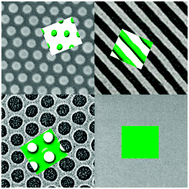Simulation methods for solvent vapor annealing of block copolymer thin films†
Abstract
Recent progress in modelling the solvent vapor annealing of thin film block copolymers is examined in the context of a self-consistent field theory framework. Key control variables in determining the final microdomain morphologies include swelling ratio or swollen film solvent volume fraction, swollen film thickness, substrate and vapor atmosphere surface energies, effective volume fraction, and effective Flory–Huggins interaction parameter. The regime of solvent vapor annealing studied is where the block copolymer has a high enough Flory–Huggins parameter that ordered structures form during swelling and are then trapped in the system through quenching. Both implicit and explicit consideration of the solvent vapor is considered to distinguish the cases in which solvent vapor leads to a non-bulk morphology. Block-selective solvents are considered based on the experimental systems of polystyrene-b-polydimethylsiloxane annealed with toluene and heptane. The results of these simulations are compared with these experiments.


 Please wait while we load your content...
Please wait while we load your content...